With its numerous health benefits and versatility in cooking, broccoli has become a staple in many households. But have you ever considered growing your own? Not only is it a rewarding experience, but it also ensures that you have a supply of fresh, pesticide-free broccoli right at your fingertips.
In this article, I will provide you with expert tips on how to successfully grow broccoli in your own backyard. From selecting the right variety to caring for your plants and harvesting the perfect heads, you’ll learn everything you need to know to enjoy a lush green harvest of this nutrient-packed vegetable.
Key Takeaways:
- Broccoli is a fast-growing vegetable, gaining popularity among young adults.
- Growing your own broccoli ensures a supply of fresh, pesticide-free produce.
- This article will provide expert tips on successfully growing broccoli at home.
- Topics covered include selecting the right variety, caring for your plants, and harvesting.
- By following these tips, you’ll be on your way to enjoying a bountiful harvest of delicious broccoli.
Benefits of Growing Broccoli from Seed
There are several benefits to growing broccoli from seed rather than relying on transplants. Let me share with you why starting from seeds is a great choice for your broccoli garden:
- Cost-effective: Growing broccoli from seed is a cost-effective method. A single packet of seeds can yield hundreds of plants, giving you a bountiful harvest without breaking the bank.
- Wide variety of options: When you start from seeds, you have a wider range of varieties to choose from. Each variety offers its own unique flavor and characteristics, allowing you to experiment and find the perfect broccoli for your taste buds.
- Control over growing conditions: By starting your own seeds, you have complete control over the growing conditions. You can ensure that your plants are organically grown, free from any harmful pesticides or chemicals.
- Optimal timing: Timing is crucial for broccoli growth, and starting from seeds allows you to time the planting perfectly. You can align the growth cycle with your local climate, ensuring optimal growth and a rewarding harvest.
By growing broccoli from seed, you not only save money but also have the opportunity to explore a wide range of flavors and have control over the entire growing process. Now let me guide you through the next steps of successfully growing broccoli in your own garden.
Continue reading to discover the best practices and expert advice on growing broccoli.
Selecting the Right Broccoli Variety
When it comes to growing broccoli, selecting the right variety is key to a successful harvest. There are several factors to consider when choosing a broccoli variety, including flavor, vigor, growth habit, and maturity rate. Each variety has its own unique characteristics, so it’s important to select one that suits your taste preferences and climate conditions.
Here are some popular broccoli varieties to consider:
| Variety | Characteristics |
|---|---|
| Batavia | Compact plant with good disease resistance |
| Belstar | Produces large, dense heads with a mild flavor |
| Covina | Tolerates heat well and produces uniform heads |
| De Cicco | Early maturing variety with multiple harvests of smaller heads |
| Fiesta | Colorful and flavorful variety with purple florets |
| Waltham | Traditional variety with large heads and excellent flavor |
Remember to explore local nurseries or seed catalogs for a wider range of broccoli varieties. By selecting the right variety, you’ll be able to enjoy delicious and nutritious broccoli that thrives in your garden.
Timing and Planning for Broccoli Planting
Timing is crucial when it comes to successfully growing broccoli. This cool-season crop thrives in cool temperatures, so it’s important to plan your planting schedule accordingly. Whether you’re planting in the spring or fall, following the right timing and planning steps is key to a bountiful harvest.
Spring Planting
If you’re planning to grow broccoli in the spring, start by sowing seeds indoors approximately 6-8 weeks before the last frost date in your area. This will give the seedlings ample time to establish themselves before transplanting them outdoors.
To ensure successful transplanting:
- Choose a suitable location in your garden that receives at least 6-8 hours of direct sunlight per day. Broccoli plants thrive in full sun.
- Prepare the soil by adding organic matter such as compost or well-rotted manure to improve fertility and drainage.
- Transplant the seedlings outdoors approximately 3 weeks before the last frost date. This timing allows the plants to acclimate to outdoor conditions gradually.
- Space the seedlings about 18 inches apart, ensuring they have enough room to grow and develop.
- Water the newly transplanted seedlings regularly to keep the soil consistently moist.
Fall Planting
For fall planting, start the broccoli seeds indoors in July. This will give the seedlings enough time to grow and develop before transplanting them outdoors in mid-August.
Here are the steps to successfully grow broccoli in the fall:
- Prepare a suitable planting area in your garden, ensuring it receives adequate sunlight.
- Amend the soil with organic matter to enhance its fertility and structure.
- Start the broccoli seeds indoors in July, allowing them to grow into sturdy seedlings.
- Transplant the seedlings outdoors in mid-August, spacing them 18 inches apart.
- Provide regular watering to keep the soil moist and promote healthy growth.
By following these timing and planning steps, you’ll be well on your way to growing healthy and delicious broccoli in your garden.
Soil Preparation and Site Selection
When it comes to growing broccoli successfully, proper soil preparation and site selection are key. Broccoli thrives in fertile soil that drains well and has a neutral or slightly acidic pH. To create the ideal growing conditions, follow these important broccoli care techniques:
- Incorporate organic matter: Prepare the soil by adding organic matter such as compost or well-rotted manure. This helps improve soil structure, fertility, and water-holding capacity.
- Choose a sunny location: Select a spot in your garden that receives 6-8 hours of direct sunlight per day. Broccoli loves the sun and needs plenty of light to grow and develop its delicious heads.
- Implement crop rotation: Rotate your crops each year to prevent the buildup of pests and diseases. Avoid planting broccoli or other brassicas in the same spot consecutively, as this can lead to pest infestations and soil nutrient imbalances.
- Maintain consistent moisture: Broccoli plants benefit from consistent moisture, so make sure your garden provides an adequate water supply. Avoid overwatering, as this can lead to root rot and other fungal diseases.
- Use mulch: Apply a layer of mulch around your broccoli plants to retain soil moisture, regulate soil temperature, and suppress weed growth. Organic mulch such as straw or wood chips works well for this purpose.
By following these broccoli care techniques, you’ll create an optimal growing environment for your broccoli plants. They will reward you with healthy growth and abundant yields of delicious, nutritious broccoli heads. Take the time to prepare your soil and choose the right site, and you’ll be on your way to a successful broccoli harvest!
Planting and Caring for Broccoli Seedlings
When it comes to growing broccoli, proper planting and care are essential for ensuring healthy and productive plants. By following these best practices for growing broccoli, you can maximize your chances of success and enjoy a bountiful harvest of delicious and nutritious vegetables.
First and foremost, choose a sunny spot in your garden with fertile soil. Broccoli thrives in full sun, so make sure the area receives at least 6-8 hours of direct sunlight daily. Additionally, the soil should be well-draining and rich in organic matter. Prior to planting, prepare the soil by incorporating compost or well-rotted manure to provide your broccoli seedlings with the necessary nutrients for vigorous growth.
When planting your broccoli seedlings, space them about 18 inches apart in rows that are 2-3 feet apart. This allows enough room for the plants to grow and develop without competing for resources. A healthy spacing also improves air circulation, reducing the risk of fungal diseases.
Consistent watering is crucial for broccoli plants. Keep the soil moist but not waterlogged, as waterlogged soil can lead to root rot and other issues. Mulching around the plants helps retain moisture, regulate soil temperature, and suppress weed growth. Apply a layer of organic mulch such as straw or wood chips, leaving a gap around the stem to prevent moisture-related diseases.
Fertilize your broccoli plants every few weeks with a balanced fertilizer. This will provide them with the necessary nutrients to support healthy growth and development. Use a fertilizer that is specifically formulated for vegetables, following the instructions on the packaging for application rates.
Expert Advice: Pruning your broccoli plants is a great way to encourage the growth of large and flavorful heads. Once the central head has formed, you can prune the plant by removing the side shoots to direct the plant’s energy towards developing the main head. Pruning also allows for better air circulation and reduces the risk of pests and diseases.
If you have limited space or don’t have a garden, don’t worry! Broccoli can also be grown in containers. Choose a large pot with drainage holes, fill it with well-draining potting soil, and follow the same planting and care guidelines as for garden-grown broccoli. Just make sure the container receives adequate sunlight and regular watering.
Broccoli Planting and Caring Checklist:
- Choose a sunny spot with fertile, well-draining soil.
- Prepare the soil by incorporating compost or well-rotted manure.
- Space the seedlings 18 inches apart in rows that are 2-3 feet apart.
- Keep the soil consistently moist but not waterlogged.
- Mulch around the plants to retain moisture and suppress weeds.
- Fertilize the plants every few weeks with a balanced vegetable fertilizer.
- Prune the plants to focus growth on the central head or side shoots.
- Consider container growing for limited spaces.
| Broccoli Planting and Caring Checklist |
|---|
| Choose a sunny spot with fertile, well-draining soil. |
| Prepare the soil by incorporating compost or well-rotted manure. |
| Space the seedlings 18 inches apart in rows that are 2-3 feet apart. |
| Keep the soil consistently moist but not waterlogged. |
| Mulch around the plants to retain moisture and suppress weeds. |
| Fertilize the plants every few weeks with a balanced vegetable fertilizer. |
| Prune the plants to focus growth on the central head or side shoots. |
| Consider container growing for limited spaces. |
Harvesting and Preserving Broccoli
When it comes to harvesting broccoli, timing is key. You’ll want to wait until the heads are fully formed but still before the flowers open. This ensures that you are picking the broccoli at its peak flavor and texture. Once the heads are ready, it’s time to grab your shears and get harvesting!
A great tip is to start by cutting off the central head about a month after transplanting. This encourages the growth of side shoots, which will continue to produce smaller heads that can be harvested over a longer period of time.
When harvesting the side shoots, be sure to pick them while they are still tender. These smaller heads are just as delicious as the central head, offering a continuous supply of fresh broccoli for your meals.
Blanching and Freezing for Long-Term Storage
If you find yourself with an abundance of broccoli, you can preserve it for later use. One popular method is blanching and freezing.
To blanch broccoli, start by cutting it into bite-sized florets. Bring a pot of water to a boil and carefully drop the florets in. Blanch them for about three minutes, then promptly transfer them to an ice bath to stop the cooking process.
Once the broccoli is cooled, you can drain it and place it in freezer-safe containers or bags. Make sure to label and date the containers for easy identification. Stored in the freezer, blanched broccoli can last up to a year.
When you’re ready to use your frozen broccoli, simply thaw it out and cook it as you would fresh broccoli. It’s perfect for stir-fries, soups, casseroles, and more!
| Harvesting | Preserving |
|---|---|
| Cut the fully formed heads before flowers open | Blanch the broccoli in boiling water for 3 minutes |
| Harvest the side shoots while tender | Transfer to an ice bath to stop the cooking process |
| – | Drain and store in freezer-safe containers or bags |
| – | Label and date containers for easy identification |
So whether you enjoy broccoli fresh from the garden or prefer to preserve it for later, these harvesting and preserving techniques will ensure that you make the most of your broccoli harvest!
Common Problems and Pests
While broccoli is a hardy vegetable, it can still be susceptible to various pests and diseases. By being vigilant and taking preventive measures, you can protect your broccoli plants and ensure a successful harvest. Here are some common problems you may encounter:
Pests
Broccoli can attract pests such as cabbage worms, cabbage loopers, root maggots, and aphids. These pests can damage the leaves, stems, and heads of the plants if left unchecked. To control pests effectively, consider the following techniques:
- Regularly inspect your plants for signs of pests, such as holes in leaves, chewed edges, or discoloration.
- If you spot any pests, remove them by handpicking them off the plants.
- Introduce natural predators like ladybugs or lacewings to your garden, as they feed on common pests.
- Use organic pest control methods, such as neem oil or insecticidal soap, following the product instructions carefully.
By monitoring your plants and taking appropriate action, you can minimize the damage caused by pests and protect your broccoli crop.
Diseases
Broccoli is also susceptible to certain diseases that can affect its growth and yield. Here are some common diseases you may encounter:
| Disease | Symptoms | Prevention and Treatment |
|---|---|---|
| Blackleg | Stem rot, stunted growth, yellowing leaves. | Practice good garden hygiene by removing and destroying infected plants. Rotate crops to prevent disease buildup. |
| Black Rot | V-shaped lesions on leaves, discoloration of stems and heads. | Remove and destroy infected plants. Avoid overwatering and ensure proper plant spacing for good air circulation. |
| Clubroot | Swollen, deformed roots, stunted growth. | Use disease-resistant broccoli varieties. Improve soil drainage and avoid planting in areas with a history of clubroot. |
Proper prevention and treatment can help minimize the impact of these diseases on your broccoli plants. By practicing good garden hygiene, implementing crop rotation, and selecting disease-resistant varieties, you can significantly reduce the risk of disease.
Preventive Measures
In addition to controlling pests and diseases, there are other preventive measures you can take to ensure the health and productivity of your broccoli plants:
- Provide adequate plant spacing to allow proper air circulation and prevent overcrowding.
- Water your plants regularly, keeping the soil moist but not waterlogged.
- Apply a balanced fertilizer according to the recommended dosage to provide necessary nutrients.
- Practice crop rotation by avoiding planting broccoli in the same spot for consecutive growing seasons.
By implementing these preventive measures and staying attentive to your plants’ needs, you can effectively care for your broccoli and enjoy a bountiful harvest.
Conclusion
Growing broccoli can be a rewarding experience that allows you to enjoy a bountiful harvest of nutritious and delicious vegetables. By following the best practices for growing broccoli outlined in this article, you can successfully grow your own broccoli in your garden.
To start, choose the right variety that suits your climate and taste preferences. Plan your planting timing carefully, ensuring that you consider the ideal growing conditions for broccoli. Adequate soil preparation is essential, incorporating organic matter and selecting a sunny location with well-draining soil.
Once you have planted your broccoli seedlings, provide proper care by watering consistently, fertilizing periodically, and mulching to retain moisture and suppress weeds. Pruning can focus growth on the heads or side shoots, maximizing your harvest. Monitor your plants for common problems and pests, practicing good garden hygiene and utilizing organic pest control methods when needed.
By implementing these broccoli growing tips and best practices, you can create an optimal environment for your broccoli plants to thrive. Soon, you’ll be able to enjoy a lush green harvest of homegrown broccoli, bringing fresh and nutritious flavors to your table.

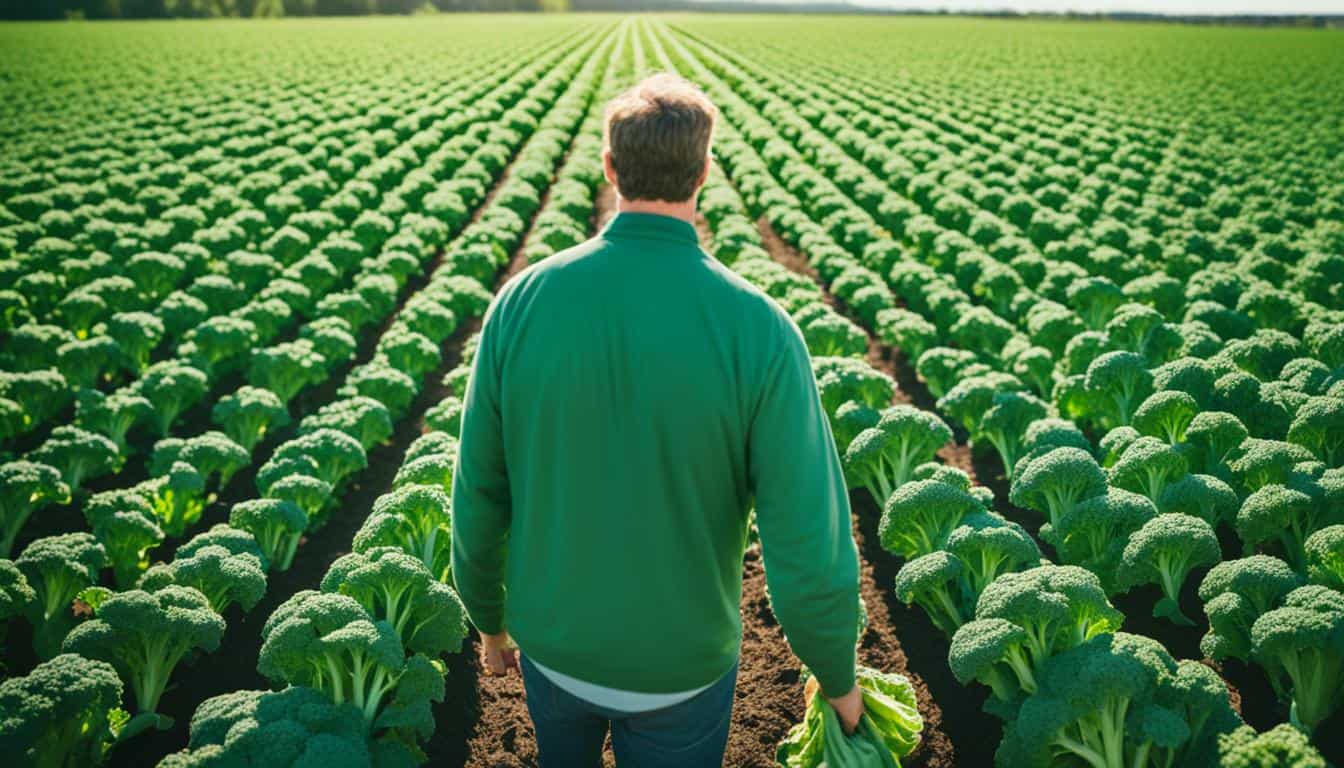
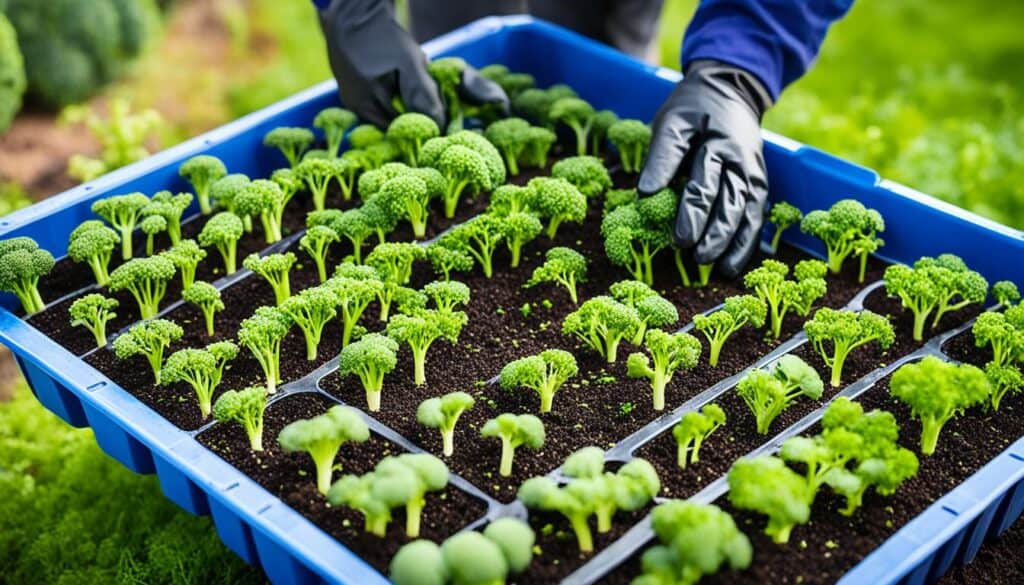
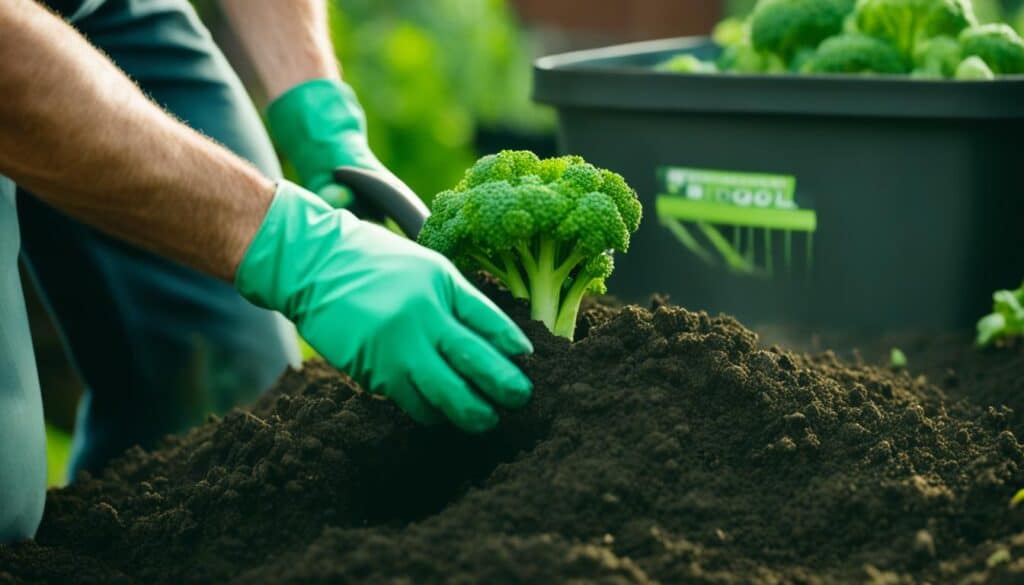
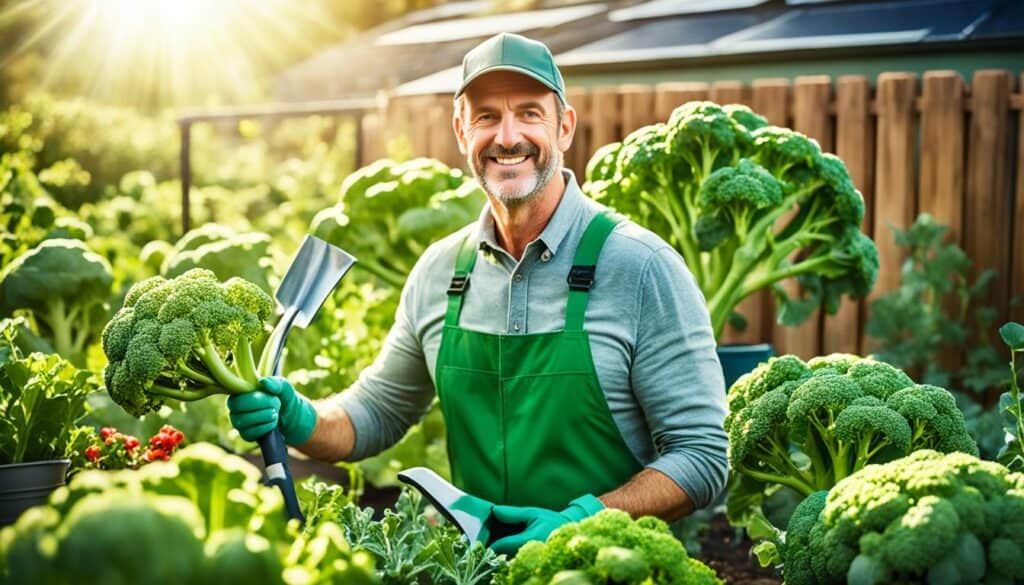
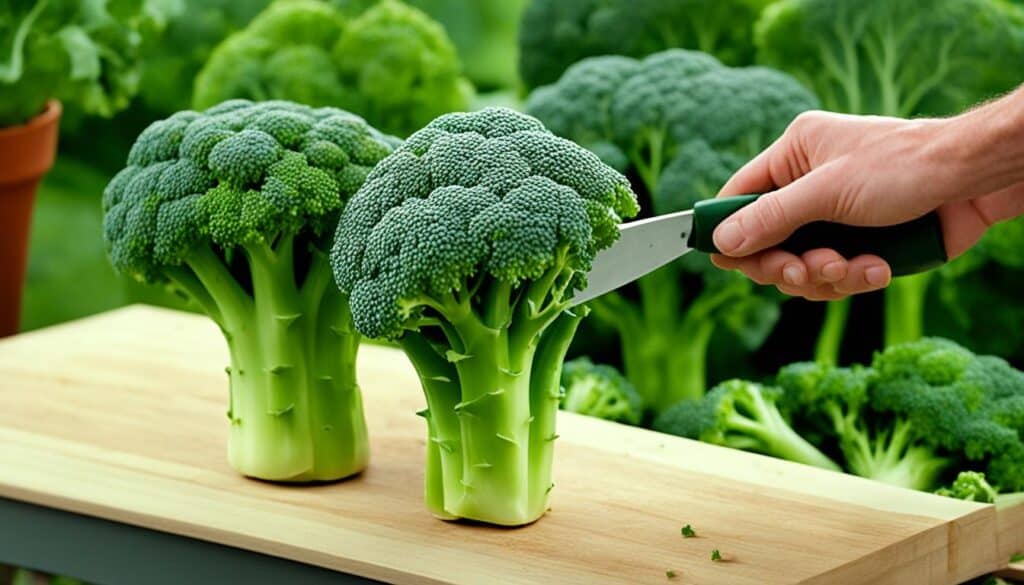




Leave a Reply